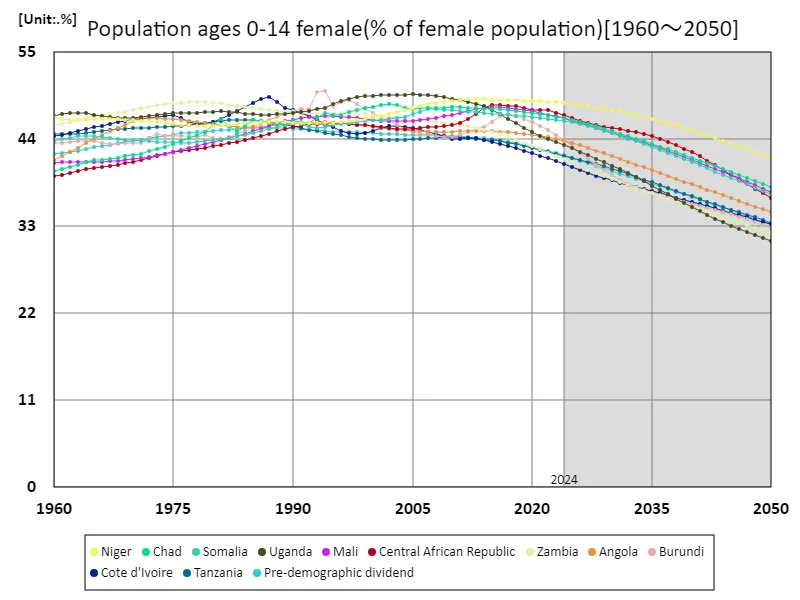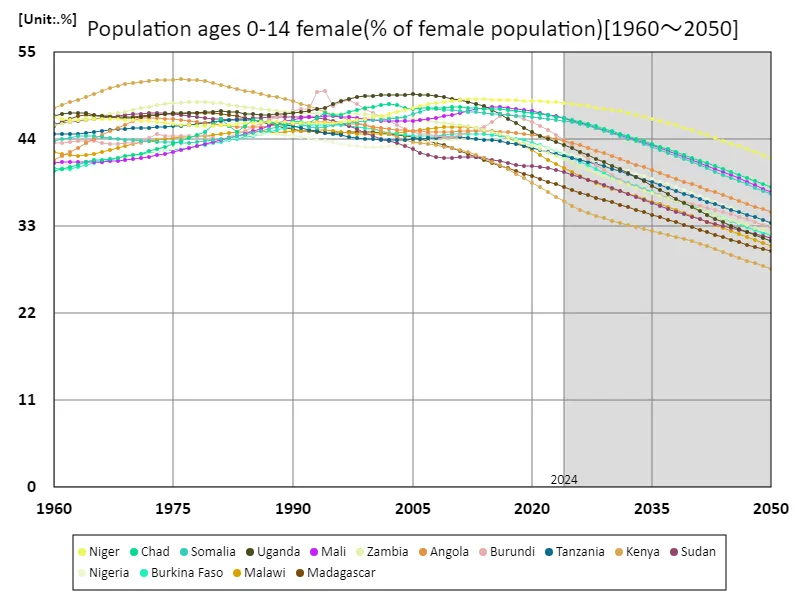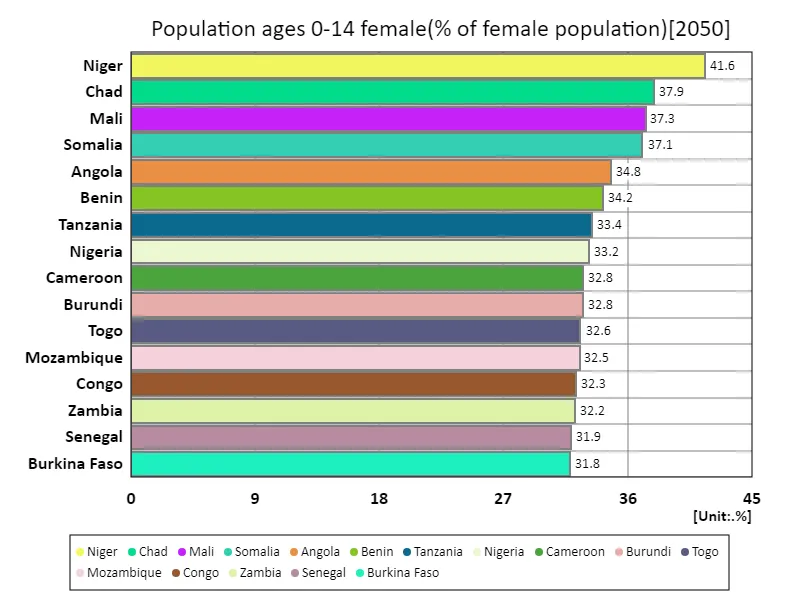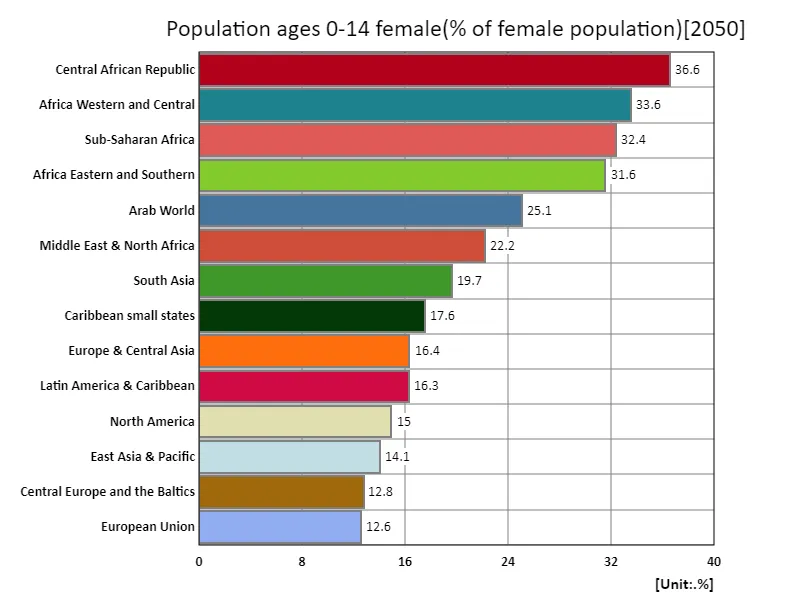Abstract
In countries like Niger, where females aged 0-14 years make up 41.6% of the population, this indicates a rapidly growing young population. This is due to high birth rates, especially in sub-Saharan Africa. Traditional family structures and low levels of education are contributing factors to high birth rates in the region. At the same time, access to education and medical care is limited in these countries, making the social and economic development of young people a challenge. Over the past few decades, Sub-Saharan Africa has seen high birth rates and a large proportion of its population being young, yet economic development has not kept pace. Sustainable development and improved education are urgently needed, with international support and local policies required. These countries’ ability to provide appropriate education and vocational training to the younger generations of their populations, improving the overall well-being of their societies, will contribute greatly to future economic growth.
Females aged 0-14 years (female population ratio)
From 1960 to 2050, the proportion of females aged 0–14 years showed large regional variations. Burundi, in particular, recorded a high rate of 50.1% in 1994, which has now risen to 65.5% compared to its previous peak. This variation is mainly due to high birth rates and relatively low death rates. From the 1960s to the 1990s, many developing countries were characterized by high birth rates, which boosted the proportion of young people. In countries like Burundi, economic development has not kept pace with the times, and the development of social education and medical infrastructure has not progressed, resulting in a high proportion of young people in the population. As we enter the 21st century, the world is experiencing an ageing population, while sub-Saharan Africa in particular continues to maintain high birth rates. However, these countries face many economic challenges and need to expand education and health services. Coordination of economic and social policies is needed between developed countries with ageing populations and developing countries with young populations. For countries like Burundi to achieve sustainable development, it is essential to expand education and employment opportunities for young people.


The maximum is 50.1%[1994] of Burundi, and the current value is about 65.5%
Females aged 0-14 years (female population ratio) (Worldwide)
Between 1960 and 2050, the proportion of females aged 0–14 years shows different trends in different countries around the world. Kenya recorded a high rate of 51.6% in 1976 and currently stands at 53.5%, exceeding its peak. This phenomenon is driven by high birth rates and relatively low mortality rates, particularly in sub-Saharan Africa. During the 1970s and 1980s, Kenya and other developing countries were characterized by high birth rates and a large proportion of young people. In countries like Kenya, slow improvements in education and health care have led to a high youth population. On the other hand, the proportion of young people has been decreasing recently due to a declining birth rate and the progress of urbanization. In Kenya’s case, a high youth population provides opportunities for economic development, but also increases the burden on education and health services. Going forward, sustainable development and strengthening education systems will be key. In particular, providing education and employment opportunities to young people is important for promoting economic growth and bringing about social stability.


The maximum is 51.6%[1976] of Kenya, and the current value is about 53.5%
Females aged 0–14 years (female population ratio) (Worldwide, latest year)
Data for 2050 shows that Niger has the highest proportion of females aged 0-14 at 41.6%, compared to the global average of 19.9%. These figures reflect regional differences in birth rates and changes in population structure. In countries like Niger, high birth rates lead to a large proportion of young people, which is mainly due to low levels of education and limited health services. Over the past few decades, fertility rates have remained high, particularly in sub-Saharan Africa, resulting in a high proportion of the population being young. This trend is driven by lack of family planning and educational opportunities, which can be an obstacle to economic growth and social development. The rapid youth population is increasing economic burdens, especially in areas where improvements in education and health services have lagged behind. Meanwhile, birth rates are declining in developed countries, and the proportion of young people is decreasing. This has resulted in changes in the labour market and an ageing population, necessitating adjustments to economic policies. Going forward, countries with large youth populations should aim for sustainable development by improving education and employment provision.


The maximum is 41.6% of Niger, the average is 19.9%, and the total is 3.88k%
Females aged 0–14 years (female population ratio) (region, latest year)
Data for 2050 shows that the Central African Republic has the highest proportion of females aged 0-14 at 36.6%, compared to the global average of 21.2%. The overall total of 318% may be due to how the data is compiled, but here we will analyze the trends by region. The high proportion in the Central African Republic continues to show high fertility rates, which are particularly prevalent in sub-Saharan Africa. These regions have experienced high birth rates over the past few decades, due primarily to a lack of access to family planning services and a lack of access to education and health care. A high youth population offers potential for future economic growth, but also puts increasing pressure on education and health services. In contrast, developed countries are experiencing declining birth rates and an aging population, resulting in a decrease in the proportion of young people. This has resulted in labor shortages and an increasing need for support for the elderly, which is having a major impact on economic policies and social security systems. In order to respond to future changes in the population structure, improvements in education and medical care will be urgently needed, especially in areas with a large young population. Meanwhile, developed countries will need policies to balance measures to address aging with sustainable economic growth.


The maximum is 36.6% of Central African Republic, the average is 21.2%, and the total is 318%



Comments